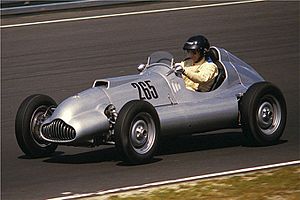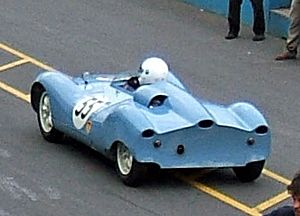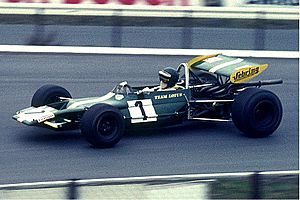Formula Two facts for kids
| Category | Single seaters |
|---|---|
| Country | International |
| Inaugural season | 1967 |
| Drivers | 25 |
| Constructors | Williams |
| Engine suppliers | Audi |
| Tyre suppliers | Avon |
| Drivers' champion | |
| Official website | FormulaTwo.com |

Formula Two, often called F2, is a type of open-wheel auto racing. It's like a stepping stone or "feeder series" for young drivers who want to reach the top level of racing, Formula One.
Formula Two was replaced by Formula 3000 in 1985. However, in 2008, the FIA (the main group that organizes racing) announced that Formula Two would return. The goal was to create a racing series that wasn't too expensive. This would give more young drivers a chance to show their skills and move up in motor racing.
Contents
What is Formula Two?
Formula Two is a type of car racing where the wheels are outside the main body of the car. These cars are very fast and need skilled drivers. Formula One is usually seen as the highest level of open-wheel racing. Because Formula One cars are so powerful and costly, a lower series like F2 is important. It helps new drivers and teams get experience before they try to join Formula One. For a long time, F2 was the main step on the racing ladder to F1.
History of Formula Two
Early Days (Before World War II)
Before World War II, there were smaller, less powerful racing cars than the main Grand Prix cars. These were often called "voiturette" cars, which means "small car." This type of racing was a good place for new drivers or smaller teams to prove themselves.
Official Start (1948–1953)
In 1946, Formula A (which later became Formula 1) was introduced. Then, in 1948, the FIA officially created Formula Two (first called Formula B). It was designed to be a smaller and cheaper racing series.
F2 cars in these early years mostly used 2.0-litre engines. This new rule brought in new car makers, like Cooper. Formula One was very expensive back then. Because of this, the World Championship Grand Prix races in 1952 and 1953 were actually run using Formula Two rules. This shows how important F2 was at the time!
F2 Grows and Changes
Formula Two changed over the years. In 1957, a new F2 format used 1.5-litre engines. Cars made by Cooper, with their engines at the back, became very successful. Porsche also had some success with cars based on their sports models. The most common engine was the Coventry-Climax FPF.
In 1959, a new series called Formula Junior was started. It tried to replace both F2 and F3. But it was decided that F2 and F3 were still needed. So, they were brought back in 1964, with F2 cars using 1.0-litre engines. Many famous Formula One drivers would also race in F2 on their days off.
By the late 1960s, people felt the difference between F1 and F2 was too big. So, a new rule for F2 was made, allowing 1.6-litre engines. This helped F2 become a strong "feeder series" for F1 again. The Cosworth FVA was a very popular engine.
In 1967, the FIA started the European Formula Two Championship. Jacky Ickx won the first championship in a Matra car. In 1972, the engine rules changed again to allow more powerful 2.0-litre engines.
Formula 3000 and GP2 Series
After the 1984 season, Formula Two was replaced by Formula 3000. This new series used F2-style cars but with bigger 3000cc engines. These engines were no longer used in Formula One, which had switched to turbo engines.
Formula 3000 was then replaced by the GP2 Series in 2005. To save money, GP2 cars used standard 4000cc V8 engines. These engines were powerful but not too expensive.
Formula Two Returns (2009–Present)
The Formula Two name came back in 2009. MotorSport Vision (MSV) won the contract to build the cars and engines for the new FIA Formula Two Championship. MSV also runs the championship.
The cars were designed by Williams Grand Prix Engineering Ltd. They have a 1.8-litre turbocharged Audi engine. These new F2 cars are designed to perform somewhere between F1 and F3 cars. The first championship was won by Andy Soucek.
Other Formula Two Series
Over the years, other Formula Two series have existed around the world. These include:
- Japanese Formula Two (now called Formula Nippon)
- Australian Formula 2 (since 1964)
- Other national series in Mexico, Brazil, Argentina, and South America.
Formula Two Champions
| Season | Driver | Team / Car | Pole positions |
Wins | Podiums | Fastest Laps |
Points | Margin (pnts) |
|---|---|---|---|---|---|---|---|---|
| European Formula Two Championship | ||||||||
| 1967 | Tyrrell Racing Matra-Cosworth |
2 | 2 | 4 | 3 | 45 | 11 | |
| 1968 | Matra Sports Matra-Cosworth |
2 | 3 | 5 | 1 | 48 | 17 | |
| 1969 | Matra International Matra-Cosworth |
1 | 1 | 2 | 1 | 37 | 9 | |
| 1970 | Tecno Racing Team Tecno-Cosworth |
2 | 3 | 5 | 1 | 44 | 9 | |
| 1971 | March Engineering March-Cosworth |
7 | 4 | 6 | 5 | 54 | 14 | |
| 1972 | Team Surtees Surtees-Cosworth |
1 | 2 | 5 | 2 | 55 | 18 | |
| 1973 | March Engineering March-BMW |
4 | 7 | 8 | 5 | 78 | 37 | |
| 1974 | March Engineering March-BMW |
3 | 4 | 6 | 2 | 54 | 11 | |
| 1975 | Ecurie Elf Martini-BMW |
6 | 6 | 7 | 4 | 60 | 24 | |
| 1976 | Equipe Elf Elf 2J-Renault |
4 | 3 | 6 | 1 | 53 | 1 | |
| 1977 | Ecurie Renault Elf Martini-Renault |
1 | 3 | 6 | 1 | 52 | 12 | |
| 1978 | Polifac BMW Junior Team March-BMW |
8 | 8 | 10 | 6 | 82 | 31 | |
| 1979 | Polifac BMW Junior Team March-BMW |
2 | 2 | 6 | 1 | 38 | 2 | |
| 1980 | Toleman Group Toleman-Hart |
2 | 3 | 9 | 7 | 61 | 19 | |
| 1981 | Ralt Racing Ltd. Ralt-Honda |
1 | 3 | 6 | 5 | 51 | 14 | |
| 1982 | March Racing Ltd. March-BMW |
2 | 5 | 7 | 3 | 57 | 1 | |
| 1983 | Ralt Racing Ltd. Ralt-Honda |
4 | 6 | 10 | 3 | 68 | 17 | |
| 1984 | Ralt Racing Ltd. Ralt-Honda |
6 | 7 | 8 | 9 | 72 | 28 | |
| FIA Formula Two Championship | ||||||||
| 2009 | MotorSport Vision Williams-Audi |
2 | 7 | 11 | 3 | 115 | 51 | |
| 2010 | MotorSport Vision Williams-Audi |
|||||||
Images for kids
-
Peter Scharmann's 1978 March–BMW car.
See also
 In Spanish: Fórmula 2 para niños
In Spanish: Fórmula 2 para niños







